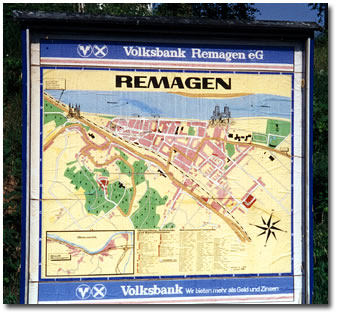|
|
|
|
|
|
 |
 |
|
|
| 9th
Infantry Division — World
War II — Remagen, Germany |
|
|
|
 |
 |
 |
 |
 |
 |
 |
|
Map
of the city of Remagen is
located near the entrance
to the Ludendorff Bridge Museum
|
In March 1945,
the Allies had been successful in
pushing the Germans back into their
homeland, but one crucial event needed
to be facilitated to speed up war's
end — the crossing of the Rhine
River.
At this point in the war, the Germans
had destroyed all bridges across the
Rhine River except for the Ludendorff
Bridge at Remagen. The bridge was
mainly used for trains and pedestrians,
but the Germans knew the Allies could
push not only infantry across the
bridge, but tanks and other armor.
The Germans had placed demolitions
across the bridge and were awaiting
orders to send it into the Rhine River.
Thanks to the 9th Armored Division,
the Allies discovered the bridge was
still intact and ordered all available
units near the bridge to seize the
critical objective. The 47th Infantry
Regiment of the 9th Infantry Division
was the first complete infantry regiment
to cross the Rhine River at Remagen.
The following text, taken from Joseph
B. Mittelman's Eight Stars to Victory:
A History of the Veteran Ninth U.S.
Infantry Division, explains in
detail the role of the 9th Infantry
Division at Remagen, Germany:
"By the morning of March 7, 1945,
all the bridges across the Rhine River
had been blown — except one .
. . that was the Ludendorff Bridge
below the small town of Remagen. Members
of the 39th and 47th infantry regiments
of the First World War knew this site
well; it was here that they had encamped
and many of the best photographs snapped
of the period show members of the
47th Infantry standing guard on this
span. Other than the old-timers, however,
few Americans on this morning knew
anything of the obscure railroad bridge
which stretched across the southern
end of Remagen and burrowed into a
tunnel on the eastern side of the
Rhine.
"For several weeks the First
Army had been plugging away hopefully
at the directive that units should
seize opportunities which would enable
them to open a bridgehead over the
Rhine. It so happened that on the
7th, units of the III Corps were spreading
southward to make contact with elements
of the Third U.S. Army. Major General
John Millikin had been fighting his
III Corps ostensibly toward the strongpoint
city of Bonn . . . at least that is
what the Fifth Panzer Army thought.
Actually, the main thrust of the III
Corps was aimed across the front of
the Germans at Bonn and was directed
more to the south, near Remagen and
the juncture of the Rhine and Ahr
rivers. Remagen was on the boundary
between the German Seventh Army and
the Fifth Panzer Army; the Fifth had
left the Seventh to defend the region
and the surprising pivoting of the
III American Corps caught the Seventh
off balance.
"During the 6th, elements of
the 9th Armored Division were able
to break through the enemy lines completely
and the armored spearheads carried
on — irrespective of flanking
protection — until they reached
Remagen and the Rhine during the following
day." [ story
continued . . . ]
[ Back
to Photographs • Next
Photograph ]
|
 |
 |
 |
|
|
 |
|
 |
|
|
|
|
|
|
|
|
|
 |
 |
|
